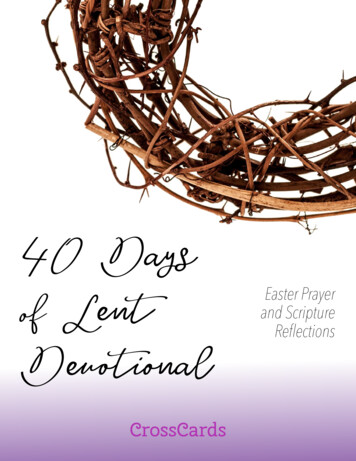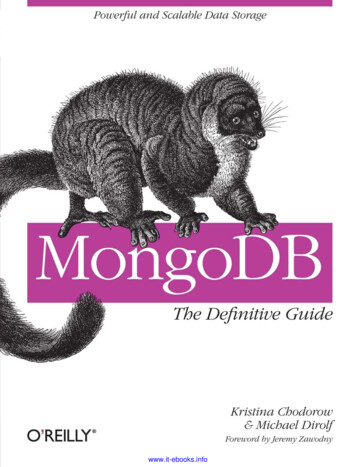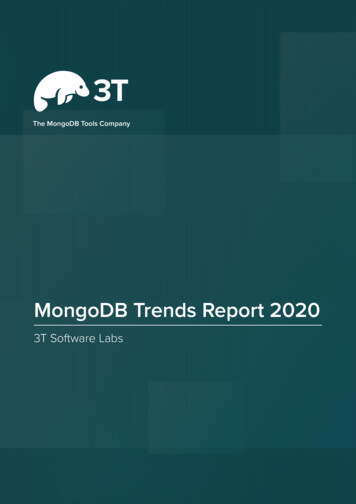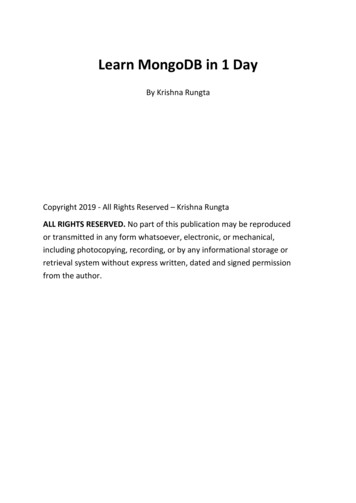
Transcription
Learn MongoDB in 1 DayBy Krishna RungtaCopyright 2019 - All Rights Reserved – Krishna RungtaALL RIGHTS RESERVED. No part of this publication may be reproducedor transmitted in any form whatsoever, electronic, or mechanical,including photocopying, recording, or by any informational storage orretrieval system without express written, dated and signed permissionfrom the author.
Table Of ContentChapter 1: What is MongoDB? Introduction, Architecture, Features &Example1.2.3.4.5.6.MongoDB FeaturesMongoDB ExampleKey Components of MongoDB ArchitectureWhy Use MongoDB?Data Modelling in MongoDBDifference between MongoDB & RDBMSChapter 2: NoSQL Tutorial: Learn NoSQL Features, Types, What is,Advantages1.2.3.4.5.6.7.8.9.10.What is NoSQL?Why NoSQL?Brief History of NoSQL DatabasesFeatures of NoSQLTypes of NoSQL DatabasesQuery Mechanism tools for NoSQLWhat is the CAP Theorem?Eventual ConsistencyAdvantages of NoSQLDisadvantages of NoSQLChapter 3: How to Download & Install MongoDB on Windows1.2.3.4.Download & Install MongoDB on WindowsHello World MongoDB: JavaScript DriverInstall Python DriverInstall Ruby Driver
5. Install MongoDB Compass- MongoDB Management Tool6. MongoDB Configuration, Import, and Export7. Configuring MongoDB server with configuration fileChapter 4: Install MongoDB in Cloud: AWS, Google, AzureChapter 5: How to Create Database & Collection in MongoDB1. Creating a database using “use” command2. Creating a Collection/Table using insert()3. Adding documents using insert() commandChapter 6: Add MongoDB Array using insert() with ExampleChapter 7: Mongodb Primary Key: Example to set id field withObjectId()Chapter 8: MongoDB Query Document using find() with ExampleChapter 9: MongoDB Cursor Tutorial: Learn with EXAMPLEChapter 10: MongoDB order with Sort() & Limit() Query withExamples1. What is Query Modifications?2. MongoDB Limit Query Results3. MongoDB Sort by Descending OrderChapter 11: MongoDB Count() & Remove() Functions with ExamplesChapter 12: MongoDB Update() Document with Example1. Basic document updates
2. Updating Multiple ValuesChapter 13: MongoDB Security, Backup & Monitoring1.2.3.4.MongoDB Security OverviewMongodb Backup ProceduresMongodb MonitoringMongoDB Indexing and Performance ConsiderationsChapter 14: How to Create User & add Role in MongoDB1. MongoDB Create User for Single Database2. Managing usersChapter 15: Configure MongoDB with KerberosAuthentication: X.509 Certificates1. MongoDB Authentication using x.509 Certificates2. Mongodb Authentication with KerberosChapter 16: MongoDB Replica Set Tutorial: Step by Step ReplicationExample1.2.3.4.Replica Set: Adding the First Member using rs.initiate()Replica Set: Adding a Secondary using rs.add()Replica Set: Reconfiguring or Removing using rs.remove()Troubleshooting Replica SetsChapter 17: MongoDB Sharding: Step by Step Tutorial with Example1. How to Implement Sharding2. Step by Step Sharding Cluster ExampleChapter 18: MongoDB Indexing Tutorial - createIndex(),
dropindex() Example1.2.3.4.Understanding Impact of IndexesHow to Create Indexes: createIndex()How to Find Indexes: getindexes()How to Drop Indexes: dropindex()Chapter 19: MongoDB Regular Expression (Regex) with Examples1.2.3.4.Using regex operator for Pattern matchingPattern Matching with optionsPattern matching without the regex operatorFetching last ‘n’ documents from a collection
Chapter 1: What is MongoDB?Introduction, Architecture, Features &ExampleWhat is MongoDB?MongoDB is a document-oriented NoSQL database used for high volumedata storage. MongoDB is a database which came into light around themid-2000s. It falls under the category of a NoSQL database.MongoDB Features1. Each database contains collections which in turn containsdocuments. Each document can be different with a varying numberof fields. The size and content of each document can be differentfrom each other.2. The document structure is more in line with how developersconstruct their classes and objects in their respective programminglanguages. Developers will often say that their classes are not rowsand columns but have a clear structure with key-value pairs.3. As seen in the introduction with NoSQL databases, the rows (ordocuments as called in MongoDB) doesn’t need to have a schemadefined beforehand. Instead, the fields can be created on the fly.4. The data model available within MongoDB allows you to representhierarchical relationships, to store arrays, and other more complexstructures more easily.5. Scalability – The MongoDB environments are very scalable.Companies across the world have defined clusters with some ofthem running 100 nodes with around millions of documents
within the databaseMongoDB ExampleThe below example shows how a document can be modeled inMongoDB.1. The id field is added by MongoDB to uniquely identify thedocument in the collection.2. What you can note is that the Order Data (OrderID, Product, andQuantity ) which in RDBMS will normally be stored in a separate table,while in MongoDB it is actually stored as an embedded document inthe collection itself. This is one of the key differences in how data ismodeled in MongoDB.Key Components of MongoDB ArchitectureBelow are a few of the common terms used in MongoDB1. id – This is a field required in every MongoDB document. Theid field represents a unique value in the MongoDB document. Theid field is like the document’s primary key. If you create a
new document without an id field, MongoDB will automatically createthe field. So for example, if we see the example of the above customertable, Mongo DB will add a 24 digit unique identifier to each document inthe 4563479cc9a8a4246bd57d7842233Trevor SmithNicole2223332. Collection – This is a grouping of MongoDB documents. A collection isthe equivalent of a table which is created in any other RDMS such asOracle or MS SQL. A collection exists within a single database. As seenfrom the introduction collections don’t enforce any sort of structure.3. Cursor – This is a pointer to the result set of a query. Clients can iteratethrough a cursor to retrieve results.4. Database – This is a container for collections like in RDMS wherein itis a container for tables. Each database gets its own set of files on thefile system. A MongoDB server can store multiple databases.5. Document - A record in a MongoDB collection is basically called adocument. The document, in turn, will consist of field name and values.6. Field - A name-value pair in a document. A document has zero or morefields. Fields are analogous to columns in relational databases.The following diagram shows an example of Fields with Key value pairs.So in the example below CustomerID and 11 is one of the key valuepair’s defined in the document.
7. JSON – This is known as JavaScript Object Notation. This is a humanreadable, plain text format for expressing structured data. JSON iscurrently supported in many programming languages.Just a quick note on the key difference between the id field and anormal collection field. The id field is used to uniquely identify thedocuments in a collection and is automatically added by MongoDB whenthe collection is created.Why Use MongoDB?Below are the few of the reasons as to why one should start usingMongoDB1. Document-oriented – Since MongoDB is a NoSQL type database,instead of having data in a relational type format, it stores the data indocuments. This makes MongoDB very flexible and adaptable to realbusiness world situation and requirements.2. Ad hoc queries - MongoDB supports searching by field, range queries,and regular expression searches. Queries can be made to returnspecific fields within documents.3. Indexing - Indexes can be created to improve the performance ofsearches within MongoDB. Any field in a MongoDB document can beindexed.4. Replication - MongoDB can provide high availability with replica
sets. A replica set consists of two or more mongo DB instances. Eachreplica set member may act in the role of the primary or secondaryreplica at any time. The primary replica is the main server whichinteracts with the client and performs all the read/write operations.The Secondary replicas maintain a copy of the data of the primaryusing built-in replication. When a primary replica fails, the replica setautomatically switches over to the secondary and then it becomes theprimary server.5. Load balancing - MongoDB uses the concept of sharding to scalehorizontally by splitting data across multiple MongoDB instances.MongoDB can run over multiple servers, balancing the load and/orduplicating data to keep the system up and running in case of hardwarefailure.Data Modelling in MongoDBAs we have seen from the Introduction section, the data in MongoDB has aflexible schema. Unlike in SQL databases, where you must have a table’sschema declared before inserting data, MongoDB’s collections do notenforce document structure. This sort of flexibility is what makes MongoDBso powerful.When modeling data in Mongo, keep the following things in mind1. What are the needs of the application – Look at the business needsof the application and see what data and the type of data neededfor the application. Based on this, ensure that the structure of thedocument is decided accordingly.2. What are data retrieval patterns – If you foresee a heavy queryusage then consider the use of indexes in your data model toimprove the efficiency of queries.3. Are frequent insert’s, updates and removals happening in thedatabase – Reconsider the use of indexes or incorporate sharding ifrequired in your data modeling design to improve the efficiency ofyour overall MongoDB environment.
Difference between MongoDB & RDBMSBelow are some of the key term differences between MongoDB andRDBMSRDBMSMongoDB DifferenceIn RDBMS, the table contains the columns and rows which are used to storethe data whereas, in MongoDB, this same structure is known as a collection.TableCollection The collection contains documents which in turn contains Fields, which inturn are key-value pairs.In RDBMS, the row represents a single, implicitly structured data item in aRowDocumenttable. In MongoDB, the data is stored in documents.In RDBMS, the column denotes a set of data values. These in MongoDB areColumn Fieldknown as Fields.In RDBMS, data is sometimes spread across various tables and in order toshow a complete view of all data, a join is sometimes formed across tables toEmbedded get the data. In MongoDB, the data is normally stored in a single collection,Joinsdocuments but separated by using Embedded documents. So there is no concept of joinsin MongoDB.Apart from the terms differences, a few other differences are shownbelow1. Relational databases are known for enforcing data integrity. This isnot an explicit requirement in MongoDB.2. RDBMS requires that data be normalized first so that it can preventorphan records and duplicates Normalizing data then has therequirement of more tables, which will then result in more table joins,thus requiring more keys and indexes.As databases start to grow, performance can start becoming an issue.Again this is not an explicit requirement in MongoDB. MongoDB isflexible and does not need the data to be normalized first.
Chapter 2: NoSQL Tutorial: Learn NoSQLFeatures, Types, What is, AdvantagesWhat is NoSQL?NoSQL is a non-relational DMS, that does not require a fixed schema, avoidsjoins, and is easy to scale. NoSQL database is used for distributed data storeswith humongous data storage needs. NoSQL is used for Big data and realtime web apps. For example, companies like Twitter, Facebook, Google thatcollect terabytes of user data every single day.NoSQL database stands for “Not Only SQL” or “Not SQL.” Though a betterterm would NoREL NoSQL caught on. Carl Strozz introduced the NoSQLconcept in 1998.Traditional RDBMS uses SQL syntax to store and retrieve data for furtherinsights. Instead, a NoSQL database system encompasses a wide range ofdatabase technologies that can store structured, semi- structured,unstructured and polymorphic data.
Why NoSQL?The concept of NoSQL databases became popular with Internet giants likeGoogle, Facebook, Amazon, etc. who deal with huge volumes of data. Thesystem response time becomes slow when you use RDBMS for massivevolumes of data.To resolve this problem, we could “scale up” our systems by upgrading ourexisting hardware. This process is expensive.The alternative for this issue is to distribute database load on multiple hostswhenever the load increases. This method is known as “scaling out.”
NoSQL database is non-relational, so it scales out better than relationaldatabases as they are designed with web applications in mind.Brief History of NoSQL Databases1998- Carlo Strozzi use the term NoSQL for his lightweight, open- sourcerelational database2000- Graph database Neo4j is launched2004- Google BigTable is launched2005- CouchDB is launched2007- The research paper on Amazon Dynamo is released2008- Facebooks open sources the Cassandra project 2009The term NoSQL was reintroducedFeatures of NoSQLNon-relationalNoSQL databases never follow the relational modelNever provide tables with flat fixed-column records
Work with self-contained aggregates or BLOBsDoesn’t require object-relational mapping and data normalization Nocomplex features like query languages, query planners,referential integrity joins, ACIDSchema-freeNoSQL databases are either schema-free or have relaxed schemas Donot require any sort of definition of the schema of the data Offersheterogeneous structures of data in the same domainNoSQL is Schema-FreeSimple APIOffers easy to use interfaces for storage and querying dataprovidedAPIs allow low-level data manipulation & selection methods Textbased protocols mostly used with HTTP REST with JSON Mostly usedno standard based query languageWeb-enabled databases running as internet-facing servicesDistributedMultiple NoSQL databases can be executed in a distributed
fashionOffers auto-scaling and fail-over capabilitiesOften ACID concept can be sacrificed for scalability and throughputMostly no synchronous replication between distributed nodesAsynchronous Multi-Master Replication, peer-to-peer, HDFSReplicationOnly providing eventual consistencyShared Nothing Architecture. This enables less coordination andhigher distribution.NoSQL is Shared Nothing.Types of NoSQL DatabasesThere are mainly four categories of NoSQL databases. Each of thesecategories has its unique attributes and limitations. No specific databaseis better to solve all problems. You should select a database
based on your product needs. Letsee all of them:Key-value Pair BasedColumn-oriented GraphGraphs based DocumentorientedKey Value Pair BasedData is stored in key/value pairs. It is designed in such a way to handle lotsof data and heavy load.Key-value pair storage databases store data as a hash table where each keyis unique, and the value can be a JSON, BLOB(Binary Large Objects), string,etc.For example, a key-value pair may contain a key like “Website”associated with a value like “Guru99”.It is one of the most basic types of NoSQL databases. This kind of NoSQLdatabase is used as a collection, dictionaries, associative arrays, etc. Keyvalue stores help the developer to store schema-less data. They work bestfor shopping cart contents.Redis, Dynamo, Riak are some examples of key-value store DataBases.
They are all based on Amazon’s Dynamo paper.Column-basedColumn-oriented databases work on columns and are based on BigTablepaper by Google. Every column is treated separately. Values of singlecolumn databases are stored contiguously.Column based NoSQL databaseThey deliver high performance on aggregation queries like SUM, COUNT,AVG, MIN etc. as the data is readily available in a column.Column-based NoSQL databases are widely used to manage datawarehouses, business intelligence, CRM, Library card catalogs,HBase, Cassandra, HBase, Hypertable are examples of column baseddatabase.Document-Oriented:Document-Oriented NoSQL DB stores and retrieves data as a key value pairbut the value part is stored as a document. The document is stored in JSONor XML formats. The value is understood by the DB and can
be queried.Relational Vs. DocumentIn this diagram on your left you can see we have rows and columns, and inthe right, we have a document database which has a similar structure toJSON. Now for the relational database, you have to know what columns youhave and so on. However, for a document database, you have data storelike JSON object. You do not require to define which make it flexible.The document type is mostly used for CMS systems, blogging platforms,real-time analytics & e-commerce applications. It should not use forcomplex transactions which require multiple operations or queries againstvarying aggregate structures.Amazon SimpleDB, CouchDB, MongoDB, Riak, Lotus Notes,MongoDB, are popular Document originated DBMS systems.Graph-BasedA graph type database stores entities as well the relations amongst thoseentities. The entity is stored as a node with the relationship as edges. Anedge gives a relationship between nodes. Every node and edge has aunique identifier.
Compared to a relational database where tables are loosely connected, aGraph database is a multi-relational in nature. Traversing relationship is fastas they are already captured into the DB, and there is no need to calculatethem.Graph base database mostly used for social networks, logistics, spatial data.Neo4J, Infinite Graph, OrientDB, FlockDB are some popular graph- baseddatabases.Query Mechanism tools for NoSQLThe most common data retrieval mechanism is the REST-basedretrieval of a value based on its key/ID with GET resourceDocument store Database offers more difficult queries as theyunderstand the value in a key-value pair. For example, CouchDBallows defining views with MapReduceWhat is the CAP Theorem?
CAP theorem is also called brewer’s theorem. It states that is impossiblefor a distributed data store to offer more than two out of threeguarantees1. Consistency2. Availability3. Partition ToleranceConsistency:The data should remain consistent even after the execution of an operation.This means once data is written, any future read request should containthat data. For example, after updating the order status, all the clients shouldbe able to see the same data.Availability:The database should always be available and responsive. It should not haveany downtime.Partition Tolerance:Partition Tolerance means that the system should continue to function evenif the communication among the servers is not stable. For example, theservers can be partitioned into multiple groups which may not communicatewith each other. Here, if part of the database is unavailable, other parts arealways unaffected.Eventual ConsistencyThe term “eventual consistency” means to have copies of data on multiplemachines to get high availability and scalability. Thus, changes made toany data item on one machine has to be propagated to other replicas.Data replication may not be instantaneous as some copies will be updatedimmediately while others in due course of time. These copies may bemutually, but in due course of time, they become consistent.
Hence, the name eventual consistency.BASE: Basically Available, Soft state, Eventual consistencyBasically, available means DB is available all the time as per CAPtheoremSoft state means even without an input; the system state maychangeEventual consistency means that the system will becomeconsistent over timeAdvantages of NoSQLCan be used as Primary or Analytic Data Source BigData CapabilityNo Single Point of Failure EasyReplicationNo Need for Separate Caching Layer
It provides fast performance and horizontal scalability.Can handle structured, semi-structured, and unstructured data withequal effectObject-oriented programming which is easy to use and flexible NoSQLdatabases don’t need a dedicated high-performance server SupportKey Developer Languages and PlatformsSimple to implement than using RDBMSIt can serve as the primary data source for online applications.Handles big data which manages data velocity, variety, volume, andcomplexityExcels at distributed database and multi-data center operationsEliminates the need for a specific caching layer to store data Offers aflexible schema design which can easily be altered without downtime orservice disruptionDisadvantages of NoSQLNo standardization rulesLimited query capabilitiesRDBMS databases and tools are comparatively matureIt does not offer any traditional database capabilities, likeconsistency when multiple transactions are performedsimultaneously.When the volume of data increases it is difficult to maintainunique values as keys become difficultDoesn’t work as well with relational data Thelearning curve is stiff for new developersOpen source options so not so popular for enterprises.SummaryNoSQL is a non-relational DMS, that does not require a fixedschema, avoids joins, and is easy to scale
The concept of NoSQL databases beccame popular with Internetgiants like Google, Facebook, Amazon, etc. who deal with hugevolumes of dataIn the year 1998- Carlo Strozzi use the term NoSQL for his lightweight,open-source relational databaseNoSQL databases never follow the relational model it is eitherschema-free or has relaxed schemasFour types of NoSQL Database are 1).Key-value Pair Based2).Column-oriented Graph 3).Graphs based 4).DocumentorientedNOSQL can handle structured, semi-structured, and unstructured datawith equal effectCAP theorem consists of three words Consistency, Availability, andPartition ToleranceBASE stands for Basically Available, Soft state, EventualconsistencyThe term “eventual consistency” means to have copies of data onmultiple machines to get high availability and scalability NOSQL offerlimited query capabilities
Chapter 2: NoSQL Tutorial: Learn NoSQL Features, Types, What is, Advantages What is NoSQL? NoSQL is a non-relational DMS, that does not require a fixed schema, avoids joins, and is easy to scale. NoSQL database is used for distributed data stores with humongous data storage needs. NoSQL is used for Big data and real-time web apps.
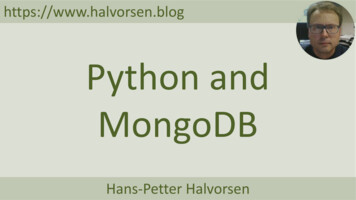
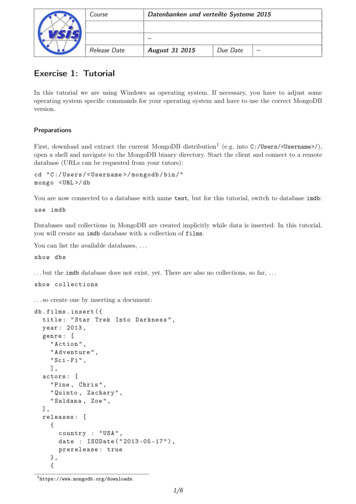


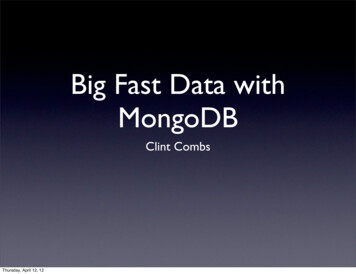
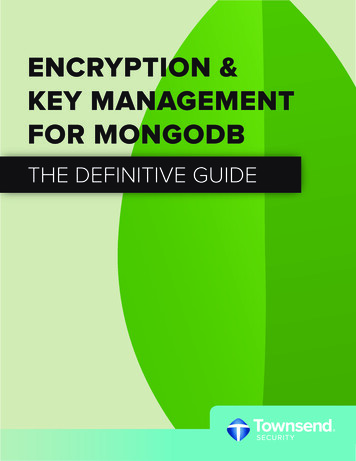
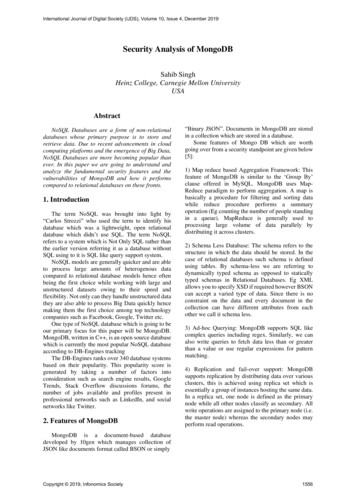
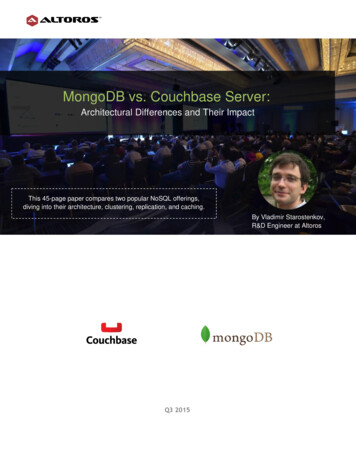
![Welcome [dashdiet.me]](/img/17/30-day-weight-loss-journal.jpg)
